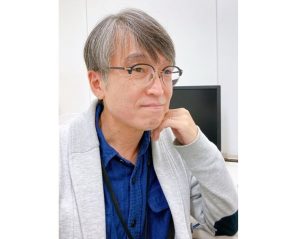Matsuo, Motoyuki

Matsuo, Motoyuki
Project Professor
Vice Chairman, Education Division, The Japan Society of Nuclear and Radiochemical Sciences
Vice Chairman, The Japan Association of Activation Analysis
Radiation Worker
Areas of expertise
Radiochemistry, Environmental Analytical Chemistry
Description of your research
“Observing the environment through the chemical state of substance!”
A study on the marine sedimentary environments under the hypoxia in Tokyo-bay by non-destructive speciation of elements and radioactivity analysis.
It has been pointed out that the dredged trench may be a trigger for the generation of hypoxia in Tokyo Bay. We considered that the history of past hypoxia is recorded in the bottom sediments directly below, and investigated the relationship between hypoxia and the sedimentary environment of the dredged trench by collecting the sediments in the vertical direction and analyzing the chemical state of elements. The core sediments were collected from the dredged trench and the natural seabed off Makuhari, Chiba Prefecture, and off Yokohama. 57Fe Mössbauer spectra were used to determine the abundance ratio of iron by chemical state in stratified samples, and it was estimated that the area off Yokohama was more oxidative than that off Makuhari, and the dredged trench was the most reducing. It was suggested that it would be a good indicator of dissolved oxygen content. We also focused on the concentration of redox sensitive elements in the sediments and investigated their relationship to the redox status of water quality. As a result, it was found that the concentration of Mn, which is an index of the oxidation state, is low in the dredged trench, which is a specific reducing environment compared to other sites. From the values of Ce/U and Th/ U ratios, it was found that the environment was reduced in the order of Yokohama offshore <Makuhari offshore natural seabed <Makuhari offshore dredging trench. This method was found to be very effective in investigating the redox state of sediments more precisely.
A study on physical properties and functions of perovskite-type oxides containing Fe by Mössbauer spectroscopy.
Oxygen storage materials are expected to be applied to three-way catalysts for automobile exhaust gas purification and other applications because oxygen can be moved in and out of the crystal lattice using the valence change of transition metal ions caused by changes in oxygen partial pressure and temperature. For example, it has been shown that partial substitution of In into the Fe site of BaFeO3−δ leads to a perovskite structure with an irregular arrangement of oxygen defect, which improves the oxygen absorption and desorption properties. We have elucidated by 57Fe Mössbauer spectroscopy that the chemical state of Fe in this material is antiferromagnetic Fe3+ with a large relaxation effect in samples with large oxygen deficiency δ after degassing, and paramagnetic with a mixture of Fe3+ and Fe4+ when δ is reduced by gas absorption. Thus, the Mössbauer spectrum for functional materials containing Fe provides direct information on the reduced species (Fe) and can be an important insight into the properties of such materials. Recently, it was found that substituting Y at the Sr site in SrFeO3−δ disrupts the oxygen deficient sequence, and the possibility of a new oxygen storage material without reducing the Fe content has been identified and is under further investigation.
Elucidation of characteristics of iron elution from fertilizer using steelmaking slag for restoring seaweed beds in coastal areas.
In recent years, the decrease of seaweed beds (sea desertification) has become a problem in various parts of the coast of Japan. The deficiency of dissolved iron is considered to be one of the causes from the life history of brown algae. We developed the seaweed restoration method using the mixture of steelmaking slag and compost containing humic substances (slag-compost fertilizer). The research goal was to understand the characteristic of iron elution from the slag-compost fertilizer toward practical use of this method. Iron elution tests with small plastic containers and 300 L tanks were examined. The field investigations in river and coastal areas for estimating the dynamics of iron and organic matter were also conducted. It was found that iron elution was promoted under reducing conditions and mixing of slag and compost resulted in the activation of anaerobic microorganisms in the fertilizer contributed to reductive iron elution. 57Fe Mössbauer spectroscopy was used to obtain insights into the iron presence morphology due to differences in redox states during iron elution. In addition, the results of the field investigation indicate that the dynamics of iron and organic matter in river water, which are related to river and coastal environments, are strongly influenced by the land use in the basins.
Competitive research funds related to this research
- FY 2010-2013 Grant-in-Aid for Scientific Research (B)
"Evaluation of environmental change in the sediments under hypoxia revealed by non-destructive speciation of elements" (Principal Investigator) - FY 2013-2016 Grant-in-Aid for Scientific Research (A)
"Development of innovative technique for determining elemental and isotopic contents by using high intense pulsed neutrons and continuous neutrons" (Representative: Mitsuru Ebihara) (Co-Investigator) - FY 2015 - 2018 Grant-in-Aid for Scientific Research (C)
"A study on the marine sedimentary environments under the hypoxia in Tokyo-bay by non-destructive speciation of elements and radioactivity analysis" (Principal Investigator) - FY 2016 - 2018 Grant-in-Aid for Scientific Research (B)
"Elucidation of characteristics of iron elution from fertilizer using steelmaking slag for restoring seaweed beds in coastal areas" (Representative: Mitsuo Yamamoto) (Co-Investigator) - FY 2018 - 2020 Grant-in-Aid for Scientific Research (C)
"A study on the environment of Tokyo-bay sediments under hypoxia analyzed by chemical states of iron and radioactive cesium" (Principal Investigator)
List of publications on radiation research
- Relationship among the local structure, chemical state of Fe ions in Fe-O polyhedra, and electrical conductivity of cubic perovskite Ba1−xSrxFe0.9In0.1O3−δ with varying number of oxide ion vacancies, F. Fujishiro, C. Sasaoka, M. Oishi, T. Hashimoto, K. Shozugawa and M. Matsuo, Materials Research Bulletin, 133, 111063 (2021)
- Biodegradation and structural modification of humic acids in a compost induced by fertilization with steelmaking slag under coastal seawater, as detected by TMAH-py-GC/MS, EEM and HPSEC analyses, H. Iwai, M. Yamamoto, M. Matsuo, D. Liu and M. Fukushima, Analytical Sciences, 37, 977-984 (2021)
- Landside tritium leakage over through years from Fukushima Dai-ichi nuclear plant and relationship between countermeasures and contaminated water, K. Shozugawa, M. Hori, T.E. Johnson, N. Takahata, Y. Sano, N. Kávási, S.K. Sahoo and M. Matsuo, Scientific Reports, 10, 19925 (2020)
- Mechanism of the elution of iron from a slag-compost fertilizer for restoring seaweed beds in coastal areas - Characteristic changes of steelmaking slag and humic acids derived from the fertilizer during the elution process, M. Yamamoto, H. Iwai, M. Matsuo, D. Liu and M. Fukushima, Analytical Sciences, 36, 545-551 (2020)
- Oxygen absorption and desorption behavior of Ba0.5La0.5FeO3-δ and its effect on crystal structure and electrical conduction property, T. Okiba, K. Shozugawa, M. Matsuo and T. Hashimoto, Solid State Ionics, 346, 115191 (2020)
- A study on evaluation of redox condition of Tokyo Bay using chemical states of sedimentary iron as an indicator by means of Mössbauer spectroscopy, M. Komori, K. Shozugawa, Y. Guan and M. Matsuo, Hyperfine Interactions, 240:115, DOI: 10.1007/s10751-019-1653-0 (2019)
- Dynamics of arsenic in rivers caused by Mt. Ioyama eruption, Miyazaki prefecture, R. Takakura, K. Shozugawa, M. Hori, P. Yang and M. Matsuo, Journal of Environmental Chemistry, 29, 183-188 (2019)
- Constraints on the P-T conditions of high-pressure metamorphic rocks from the Inyoni shear zone in the mid-Archean Barberton Greenstone Belt, South Africa, D. Kato, K. Aoki, T. Komiya, S. Yamamoto, Y. Sawaki, H. Asanuma, T. Sato, Y. Tsuchiya, K. Shozugawa, M. Matsuo and B.F. Windley, Precambrian Research, 315, 1-18 (2018)
- Analysis of phase transition by variation of oxide ion content in BaFe0.9In0.1O3−δ as oxygen storage material using Mössbauer spectroscopy - discovery of magnetic phase transition with cubic structure maintained, F. Fujishiro, M. Izaki, C. Sasaoka, T. Hashimoto, K. Shozugawa and M. Matsuo, Materials Letters, 228, 497-499 (2018)
- Oxidation of antimony (III) in soil by manganese (IV) oxide using X-ray absorption fine structure, L. Fu, K. Shozugawa and M. Matsuo, J. Environmental Sciences, 73, 31-37 (2018)

